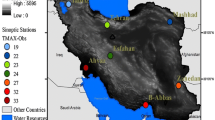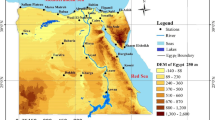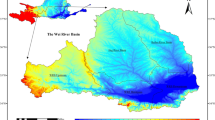Abstract
In this study, the linear scaling method used for the downscaling of temperature was extended from monthly scaling factors to daily scaling factors (SFs) to improve the daily variations in the corrected temperature. In the original linear scaling (OLS), mean monthly SFs are used to correct the future data, but mean daily SFs are used to correct the future data in the extended linear scaling (ELS) method. The proposed method was evaluated in the Jhelum River basin for the period 1986–2000, using the observed maximum temperature (Tmax) and minimum temperature (Tmin) of 18 climate stations and the simulated Tmax and Tmin of five global climate models (GCMs) (GFDL-ESM2G, NorESM1-ME, HadGEM2-ES, MIROC5, and CanESM2), and the method was also compared with OLS to observe the improvement. Before the evaluation of ELS, these GCMs were also evaluated using their raw data against the observed data for the same period (1986–2000). Four statistical indicators, i.e., error in mean, error in standard deviation, root mean square error, and correlation coefficient, were used for the evaluation process. The evaluation results with GCMs’ raw data showed that GFDL-ESM2G and MIROC5 performed better than other GCMs according to all the indicators but with unsatisfactory results that confine their direct application in the basin. Nevertheless, after the correction with ELS, a noticeable improvement was observed in all the indicators except correlation coefficient because this method only adjusts (corrects) the magnitude. It was also noticed that the daily variations of the observed data were better captured by the corrected data with ELS than OLS. Finally, the ELS method was applied for the downscaling of five GCMs’ Tmax and Tmin for the period of 2041–2070 under RCP8.5 in the Jhelum basin. The results showed that the basin would face hotter climate in the future relative to the present climate, which may result in increasing water requirements in public, industrial, and agriculture sectors; change in the hydrological cycle and monsoon pattern; and lack of glaciers in the basin.






Similar content being viewed by others
References
Akhtar M, Ahmad N, Booij MJ (2009) Use of regional climate model simulations as input for hydrological models for the Hindukush-Karakorum-Himalaya region. Hydrol Earth Syst Sci 13:1075–1089. doi:10.5194/hess-13-1075-2009
Archer DR, Fowler HJ (2008) Using meteorological data to forecast seasonal runoff on the river Jhelum, Pakistan. J Hydrol 361:10–23. doi:10.1016/j.jhydrol.2008.07.017
Babar Z, Zhi X-f, Fei G (2015) Precipitation assessment of Indian summer monsoon based on CMIP5 climate simulations. Arab J Geosci 8:4379–4392. doi:10.1007/s12517-014-1518-4
Chatfield C (2013) The analysis of time series: an introduction, Sixth Edition. CRC Press
Chen J, Brissette FP, Chaumont D, Braun M (2013) Finding appropriate bias correction methods in downscaling precipitation for hydrologic impact studies over North America. Water Resour Res 49:4187–4205. doi:10.1002/wrcr.20331
Chu J, Xia J, CY X, Singh V (2010) Statistical downscaling of daily mean temperature, pan evaporation and precipitation for climate change scenarios in Haihe River, China. Theor Appl Climatol 99:149–161. doi:10.1007/s00704-009-0129-6
Dobrovolski S (2013) Stochastic climate theory: models and applications. Springer, Berlin Heidelberg
Fowler HJ, Blenkinsop S, Tebaldi C (2007) Linking climate change modelling to impacts studies: recent advances in downscaling techniques for hydrological modelling. Int J Climatol 27:1547–1578. doi:10.1002/joc.1556
Gebremeskel S, Liu YB, de Smedt F, Hoffmann L, Pfister L (2005) Analysing the effect of climate changes on streamflow using statistically downscaled GCM scenarios. Int J River Basin Management 2:271–280. doi:10.1080/15715124.2004.9635237
Giorgi F, Hewitson B, Christensen J et al. (2001) Regional climate information-evaluation and projection. In: Houghton JT, Ding Y, Griggs DJ, Noguer M, Dai X, Maskell K (eds) Climate Change 2001: The Scientific Basis. Cambridge University Press, Cambridge, pp 585–629
Hay LE, Clark MP (2003) Use of statistically and dynamically downscaled atmospheric model output for hydrologic simulations in three mountainous basins in the western United States. J Hydrol 282:56–75
Hessami M, Gachon P, Ouarda TBMJ, St-Hilaire A (2008) Automated regression-based statistical downscaling tool. Environ Model Softw 23:813–834. doi:10.1016/j.envsoft.2007.10.004
Huang J, Zhang J, Zhang Z, Xu C, Wang B, Yao J (2011) Estimation of future precipitation change in the Yangtze river basin by using statistical downscaling method. Stoch Env Res Risk Asses 25:781–792. doi:10.1007/s00477-010-0441-9
Mahmood R, Babel M (2012) Evaluation of SDSM developed by annual and monthly sub-models for downscaling temperature and precipitation in the Jhelum basin, Pakistan and India. Theor Appl Climatol:1–18. doi:10.1007/s00704-012-0765-0
Mahmood R, Babel MS (2013) Evaluation of SDSM developed by annual and monthly sub-models for downscaling temperature and precipitation in the Jhelum basin, Pakistan and India. Theor Appl Climatol 113:27–44. doi:10.1007/s00704-012-0765-0
Mahmood R, Jia S (2016) Assessment of impacts of climate change on the water resources of the transboundary Jhelum River basin of Pakistan and India. Water 8:246. doi:10.3390/w8060246
Mpelasoka FS, Chiew FHS (2009) Influence of rainfall scenario construction methods on runoff projections. J Hydrometeorol 10:1168–1183. doi:10.1175/2009JHM1045.1
Norse EA, Conservation CfM (1993) Global marine biological diversity: a strategy for building conservation into decision making. Island Press
Ouyang F, Zhu Y, Fu G, Lü H, Zhang A, Yu Z, Chen X (2015) Impacts of climate change under CMIP5 RCP scenarios on streamflow in the Huangnizhuang catchment. Stoch Env Res Risk A 29:1781–1795. doi:10.1007/s00477-014-1018-9
Piani C, Haerter J, Coppola E (2010) Statistical bias correction for daily precipitation in regional climate models over Europe. Theor Appl Climatol 99:187–192. doi:10.1007/s00704-009-0134-9
Prasanna V (2015) Regional climate change scenarios over South Asia in the CMIP5 coupled climate model simulations. Meteorog Atmos Phys 127:561–578. doi:10.1007/s00703-015-0379-z
Salzmann N, Frei C, Vidale P-L, Hoelzle M (2007) The application of regional climate model output for the simulation of high-mountain permafrost scenarios. Glob Planet Chang 56:188–202. doi:10.1016/j.gloplacha.2006.07.006
Santer BD, Wigley TML, Schlesinger ME, Mitchell JFB (1990) Developing climate scenarios from equilibrium GCM results. Max-Planck-Institut fu¨r Meteorologie
Semenov M, Barrow E (1997) Use of a stochastic weather generator in the development of climate change scenarios. Clim Chang 35:397–414. doi:10.1023/A:1005342632279
Teutschbein C, Seibert J (2012) Bias correction of regional climate model simulations for hydrological climate-change impact studies: review and evaluation of different methods. J Hydrol:456–457 . doi:10.1016/j.jhydrol.2012.05.05212-29
Wetterhall F, Bárdossy A, Chen D, Chunf-Yu Xu SH (2006) Daily precipitation-downscaling techniques in three Chinese regions. Water Resour Res 42:W11423. doi:10.1029/2005WR004573
Wilby RL, Hay LE, Gutowski WJ et al. (2000) Hydrological responses to dynamically and statistically downscaled climate model output. Geophys Res Lett 27:1199 doi:10.1029/1999GL006078
Wilby RL, Dawson CW, Barrow EM (2002) SDSM—a decision support tool for the assessment of regional climate change impacts. Environ Model Softw 17:145–157. doi:10.1016/s1364-8152(01)00060-3
Xu C-y (1999) From GCMs to river flow: a review of downscaling methods and hydrologic modelling approaches. Prog Phys Geogr 23:229–249
Acknowledgments
This study was supported by the National Natural Science Foundation of China (41471463) and CAS-TWAS fellowship. The first author conducted this study during his postdoctoral research at the Institute of Geographic Science and Nature Resources Research (IGSNRR), the University of Chinese Academy of Sciences, China. The authors are thankful to the India Meteorological Department (IMD) and the Pakistan Meteorological Department (PMD) for providing meteorological data for this research.
Author information
Authors and Affiliations
Corresponding authors
Rights and permissions
About this article
Cite this article
Mahmood, R., JIA, S. An extended linear scaling method for downscaling temperature and its implication in the Jhelum River basin, Pakistan, and India, using CMIP5 GCMs. Theor Appl Climatol 130, 725–734 (2017). https://doi.org/10.1007/s00704-016-1918-3
Received:
Accepted:
Published:
Issue Date:
DOI: https://doi.org/10.1007/s00704-016-1918-3




